In this podcast episode, I talk about Design Thinking and how it can be a valuable tool for SLPs. So what is Design Thinking for SLP? Design Thinking is a mindset, an approach, and a framework all in one. It prioritizes empathy, collaboration, and experimentation. Design Thinking has been around for over 50 years. Historically it has been mainly used in the business world, especially in product development. But it has become an increasingly popular tool in education and healthcare in the past few decades. Design Thinking can be helpful in any situation where innovative solutions are needed.
The problem chosen for this episode is inappropriate SLP referrals from teachers. The host emphasizes that this is not about criticizing teachers, but about improving collaboration and understanding between professionals.
During the Discovery phase, the problem is reframed using a “How might we?” question, and a project plan is created. Research participants and sources of inspiration are identified, and participants share their experiences and insights.
In the Interpretation phase, themes are identified from the collected information, and important headlines are turned into action-oriented questions.
The Ideation phase is about brainstorming and generating as many ideas as possible. Team members vote on their favorite ideas and narrow them down based on constraints.
Experimentation involves creating low-stakes prototypes, getting feedback, and refining ideas. The process is not linear, and participants can return to earlier phases as needed.
The Evolution phase tracks progress, collects data, and identifies areas for further adjustments. Successes are celebrated, and stories are shared with the wider community.
The episode concludes by discussing the research base related to using Design Thinking in education, including a tutorial by Kelly Farquharson and colleagues, which specifically addresses SLPs using Design Thinking for special education eligibility determinations.
- Farquharson, K., Coleman, J. J., Moore, B. J., & Montgomery, J. K. (2021).
- Use of design thinking to inform eligibility recommendations for children with spoken language and literacy disorders in schools. Perspectives of the ASHA Special Interest Groups, 6(1), 175–183.
- https://doi.org/10.1044/2020_PERSP-20-00187
- IDEO Design Thinking for Educators Toolkit
- Kelly Farquharson’s email address: kyfarq@gmail.com
- Stanford Design Thinking Starter Kit *This is a great resource to teach your colleagues the basics of Design Thinking!
- TLL Design Thinking in Education
- Stanford Design Thinking Starter Kit
Want to stay in the loop for new speech therapy ideas and inspirations? I have put together a free Digital SLP podcast to share insight and tips on implementing your speech therapy sessions. If you are looking for fun and interactive speech therapy materials that students and SLPs both will love, check out what the Digital SLP® membership site has to offer, or sign up for our free trial now. Alternatively, check out our TpT store.
Full Transcript of Podcast: What is Design Thinking, and What Does it Have to Do With SLPs?
Episode 111 - What is Design Thinking, and What Does it Have to Do With SLPs?
Hey everyone! Welcome back to another episode of the Speech Space Podcast, which is a podcast full of tips and resources for SLPs. I am your host, Jessica Cassity, and this is Episode 111.
I'm really excited about today's episode because we are covering something that we've never discussed on the podcast before, and our topic might be new to many of you. We'll be talking about Design Thinking and how it can be a useful tool for SLPs. Before we jump in, I wanted to mention that this podcast is brought to you by The Digital SLP membership site, which is a site that features time-saving interactive digital resources that are all teletherapy platform-friendly. You can learn more or sign up for a free trial by heading on over to thedigitalslp.com/digitalslp.
All right. Let's go ahead and get started. I want to begin the episode in a way that might seem a little unusual. In a moment, I'm actually going to ask you to pause the podcast briefly, if you're in a spot where you can do that easily. While your podcast player is paused, please brainstorm the top three problems that you are currently facing in your work life as a speech-language pathologist. It's okay if some of these are long-standing problems that you've been dealing with for a while, and it's also okay if the problems have popped up recently. You could also include more general problems that you've noticed within the wider field of speech-language pathology. Just make a little mental list of some of the challenging situations that you are facing or have faced as an SLP. Okay, ready? Go ahead and hit that pause button.
Okay, welcome back. I'm guessing that it was not difficult to come up with at least three problems that you're dealing with as an SLP. I see the issues that are talked about on Facebook and Facebook groups all the time and Instagram comments, and of course, I've experienced challenges in my own life as an SLP as well. Probably some of the same challenges that you brainstormed just now. No matter how much we love our field, we can acknowledge that it has some challenges.
Here's my quick list of the problems that some of us might be facing at work, especially in the school settings. So number one, SLPs are often paid on the teachers salary schedule, and OTs and PTs are paid on a separate, higher salary schedule. Number two, scheduling IEP meetings is tough. Either they're during the school day and we have to cancel sessions with our students in order to attend, or they are before or after school, which makes our days even longer. Number three, it's challenging to find blocks of time for conducting evaluations. Four, paperwork, paperwork, paperwork, including billing. This one is true in all settings. Five, colleagues and parents often don't understand what we do. Six, sometimes we have to work in tiny spaces like closets and hallways that aren't really adequate for therapy. Seven, often we have overwhelming caseload sizes. Eight, teachers make inappropriate evaluation referrals or don't follow the required referral process.
Now that we've identified some challenges, we are going to spend the rest of this episode learning about a really positive proactive method for addressing these difficult problems. That is where Design Thinking comes in! Design Thinking is a mindset, an approach, and a framework all in one. It prioritizes empathy, collaboration, and experimentation. It's also optimistic because it's about transforming challenges into opportunities and believing that change is possible. It also normalizes mistakes and so-called failures as a natural and welcome component of learning and innovating. That sounds great, right? I think it is, and by the end of this episode, I hope that you will too. Design Thinking has been around for over 50 years. Historically, it has mostly been used in the business world, especially in product development, but in the past few decades, it has become an increasingly popular tool in education and healthcare as well. Basically, Design Thinking can be a helpful method in any situation where innovative solutions are needed.
What we're going to do today is take one of the common SLP problems that I mentioned earlier in the episode, and then use that problem as an example to take us all the way through the steps of the Design Thinking process. You may want to listen through the full episode one time, and then if you're feeling inspired, go back through it a second time and think about how you could use Design Thinking to address a specific challenging situation in your own SLP life. Because Design Thinking is used by so many organizations in so many different settings, there are sometimes different names and slightly different procedures for each phase of the process, but the core ideas are the same. In today's episode, we'll use the specific process and terminology from IDEO's excellent Design Thinking toolkit for educators, which is linked in the show notes.
For today's episode, I decided to focus on the problem of inappropriate SLP referrals from teachers. Don't worry if you're not in the schools and this example doesn't apply to you because the process is still going to be relevant. I chose this problem because it involves a need for collaboration and for empathy. It's also something that causes quite a bit of frustration for SLPs. To be clear, I love teachers and this absolutely is not about bashing teachers. It's about finding a way for professionals in different roles to understand each other better and to collaborate more effectively.
The first phase of the Design Thinking process is called Discovery. This is where we notice a problem and frame it in a new way. Usually, this reframe process involves creating a "How might we?" question. So instead of saying, "Teachers at my school don't follow the referral process correctly!!" we could ask, "How might we empower teachers to make referrals that reflect an understanding of the evaluation process?" For me, even just hearing that new question makes me feel less frustrated and more at ease. The next step in this phase is to create a project plan, including who will be involved in addressing this challenge, and when and how you'll meet. This will depend on your unique situation, but it would probably involve some combination of SLPs, teachers, and perhaps administration and support staff. Of course, no one wants more meetings, so you could try to fit your Design Thinking work into existing meetings. It might even be something that you could do as part of the extended back to school meetings at the beginning of the school year.
The Discovery phase also involves collecting a lot of stories and information. This means finding research participants seeking out sources of inspiration and immersing yourself in the challenge that you are addressing. In this case, research participants would likely be principals, SLPs, and teachers who are not in your core team. It could also be useful to interview additional experts such as special education lawyers, teacher education professors, and speech-language pathology professors. You can ask them what they think about this issue, what they've seen work in other contexts, how they would address this challenge if they had an unlimited budget, and any other types of relevant questions that you can think of.
In terms of finding inspiration, IDEO has one tip that I especially love. They suggest observing what they call "analogous settings." So this basically means that if you're in a school setting, don't just stick to educational context in your research! Think about other workplaces that might have similar challenges, and visit or learn about them as well. In our example, we might study any workplace where there are different groups of people whose work affect each other. This could be a hotel, a technology company, a hospital, or many other possible places.
One last tip for the Discovery phase is that it can be informative to learn from people's self-documentation. This is a way to really immerse yourself in the challenge that you are exploring. For example, maybe you would want to focus on the procedures that kindergarten teachers use at the beginning of the year when they have an influx of unfamiliar students and they are trying to decide who they should refer for a speech evaluation. You could provide prompts and tools for the teachers to record their thought processes and actions. This gives us a really valuable peek inside their thinking, and it doesn't require any extra meetings, but it's important for us to remember that it can feel vulnerable to participate in activities like this. So be sure to offer gratitude for their time and their honesty. Okay, so that was Discovery.
The next phase is the Design Thinking process called Interpretation. With the Interpretation phase, we start to look for themes in the information that we've been collecting throughout the Discovery phase. This can take a lot of different forms, including writing down insights and recording new questions as they come up. One great strategy to use during this phase is for each of the team members to share something that stuck out to them after the team completes a visit, research session or interview. This is a good reminder that the Design Thinking process isn't strictly sequential. You'll have moments of Interpretation within Discovery and vice versa.
This is also a good time to mention that the Design Thinking process involves a lot of post-it notes. It's great to write your notes, stories, insights, and ideas on post-its so you can move them around easily and start to group similar ideas together. Once you've grouped your notes and ideas together and identified some themes, it's time to figure out the most important headlines from everything you've learned so far. In the example that we've been using in this episode, these headlines might be statements like: "Teachers feel pressure from parents" or "Teachers aren't familiar with reliable sources for learning about speech and language development" or "Teachers have trouble remembering the multiple steps in the special education evaluation process" or "Teachers want to collaborate with SLPs but don't know how."
The final step of the Interpretation phase is to make these headlines action-oriented. One way to do this is to come up with more "How might we?" questions. In our example, we could take the headline "Teachers want to collaborate with SLPs but don't know how" and turn that into the question "How might we create dedicated time for teacher-SLP collaboration?" I really love this approach and how it helps us to see problems as opportunities.
Moving on from Interpretation, our next phase would be Ideation. This is where we think of lots of ideas. Design Thinking encourages us to come up with as many ideas as possible and to allow those ideas to be wildly out of the box. Another word for ideation is brainstorming, and that is what you and your team will be doing at this stage. You want to have a dedicated time and space for your brainstorming sessions and a specific question that you plan to explore, like "How might we create dedicated time for teacher-SLP collaboration?"
At this point in the process, Design Thinking asks us to embrace the principle that there are no bad ideas. The goal in this phase is to keep the energy positive and then to come up with lots and lots of ideas. One strategy that can help is inviting some new people to participate in the brainstorming - maybe the school OT or nurse, for example. At the end of the brainstorm session, then you're going to have everyone vote on their favorite ideas while everything is fresh. You'll also want to start narrowing down ideas based on the constraints of your particular situation. For example, maybe one of the brainstorm ideas was to have a weekly collaboration breakfast with teachers and SLPs, but classes start at 7:30 AM at your school, so the logistics of breakfast beforehand are really tricky.
Now that you have a set of ideas to focus on, the next phase is Experimentation. This is where you try out your ideas using low-stakes prototypes! Prototypes can take many different forms - a computer document, a model, a role play, a diagram, or an interaction. It's important to remember that a prototype doesn't need to be a physical object. Once you've created prototypes, you'll want to get feedback on them and then adjust your prototypes as needed. Remember that Design Thinking isn't linear, so for example, at this phase, if you get excited about a prototype idea and then get stuck because of the limited funding options, you can go back to ideation and brainstorm fundraising ideas. As your prototypes become more and more refined in response to the feedback that you receive, you can begin to implement them at your school or district.
The final phase of Design Thinking is Evolution. This is where you track how things are going and what progress is being made due to the changes that have been implemented. As SLPs, this phase should feel familiar because it's essentially taking data. You're looking for changed behaviors and relationship. You're also looking for areas where additional adjustments might be needed. In this phase, it's important to celebrate your successes. You'll also want to share stories with others and engage the wider community - even neighboring districts.
One thing that's really exciting about Design Thinking is that it can help us stay hopeful. We know that things will always change, and new problems will always pop up, especially for SLPs working in schools! With Design Thinking, we have a tool that can address any challenge, and we can always go back to the Discovery phase and start over again.
As we close out today's episode, I did want to mention that there's a strong research base related to using Design Thinking in education, and some articles are even starting to come out that are specifically related to SLPs using Design Thinking. Kelly Farquharson and colleagues published a great tutorial in 2021 that goes through the entire Design Thinking process as it relates to making special education eligibility determinations. It is a helpful resource, and I will definitely be sure to link it in the show notes for you. Unfortunately, it is not open access, but if you are an ASHA member, then it should work. You could also email Dr. Farquharson to request access.
Thank you so much for listening to today's episode. I have really enjoyed learning and talking all about Design Thinking and sharing it with all of you. I hope that you feel energized and ready to use this process to address the inevitable challenges of being an SLP no matter where you work. If you enjoyed this episode, I would be very grateful if you would take a moment to leave a five-star review to make it easier for fellow SLPs to find the show. We release new episodes twice a month on the first and third Tuesdays. Also, please don't forget to check out thedigitalslp.com/digitalslp if you're interested in exploring the membership and other content. Thanks again for listening!


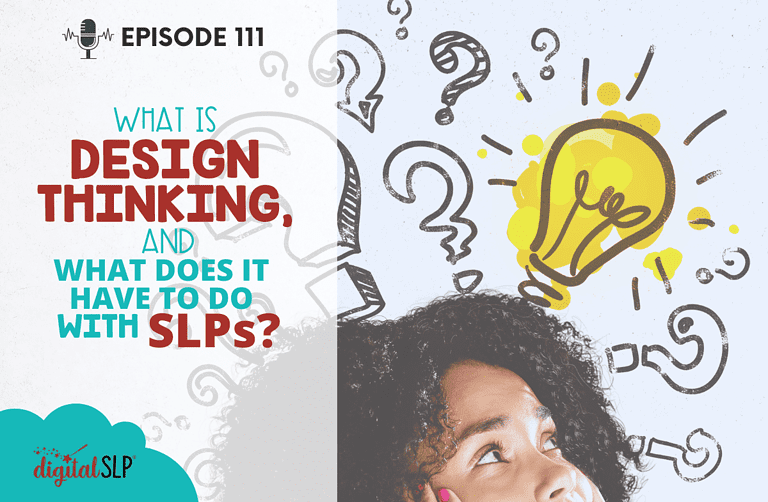



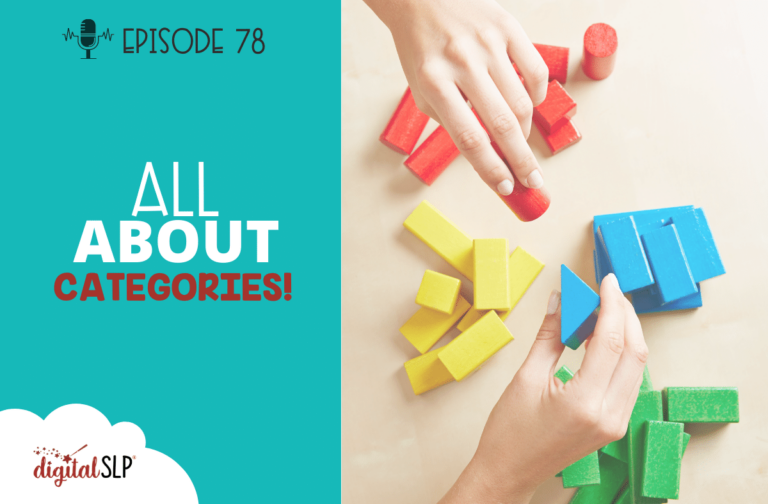
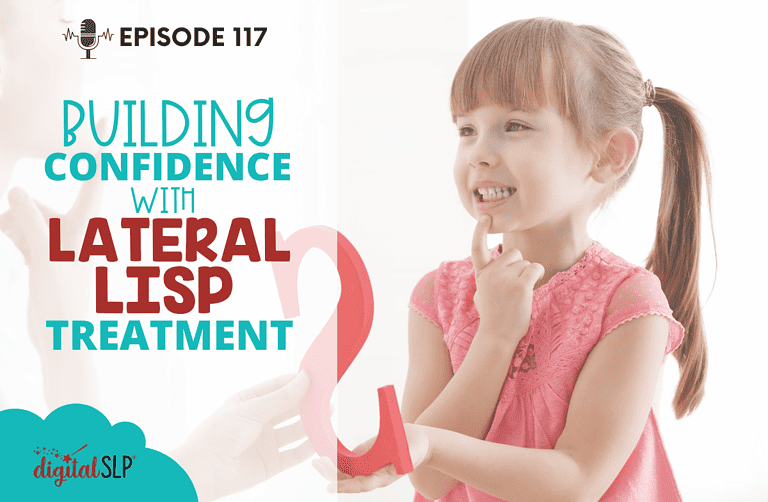

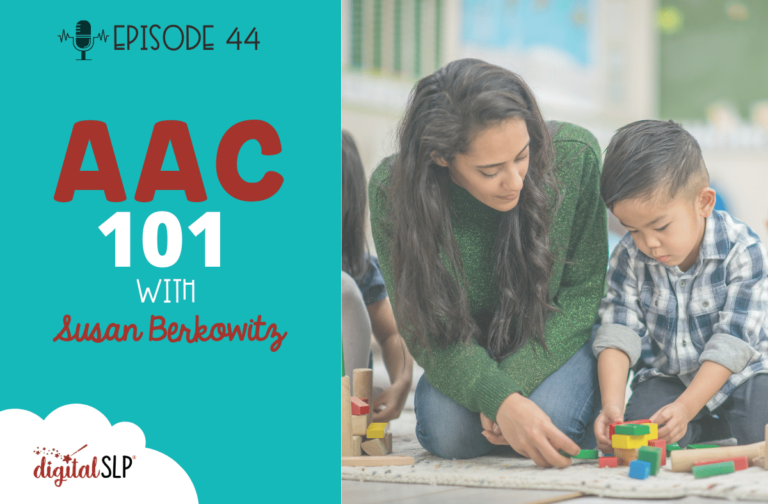
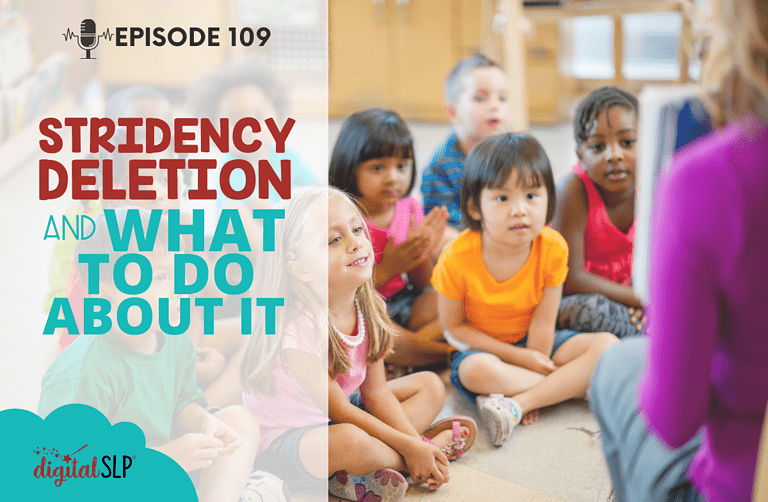


Recent Comments